Gum Disease Treatment – Hoover, AL
Experience a New Kind of Gum Disease Treatment

Advanced gum disease affects approximately half of American adults who are 30 years of age and older. This includes conditions like periodontitis, which cannot be treated with at-home oral care or a professional cleaning alone. Instead, it requires a more comprehensive approach to treatment. At Moulton Dentistry of Hoover, our team makes use of not only advanced technologies but also effective techniques to remove harmful plaque and restore your infected gum tissue as much as possible. If your gums feel sensitive or look severely inflamed, don’t wait to call our dental office directly to start gum disease treatment in Hoover.
Why Choose Moulton Dentistry of Hoover for Gum Disease Treatment?
- Soft Tissue Laser Therapy Improves Precision and Comfort
- Sedation Dentistry Available for Nervous Patients
- Calaject Technology Eases Local Anesthetic Administration
What is Gum Disease?
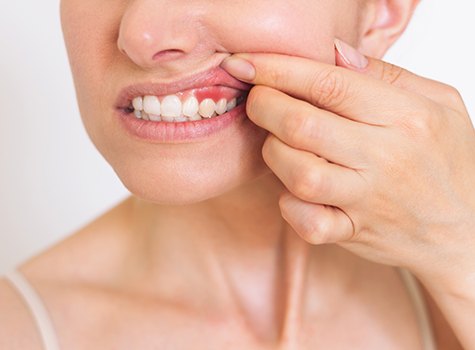
Gum disease occurs when bacteria (infection) attack the soft oral tissues that surround your teeth. Plaque and tartar accumulate over time and begin to infect the gums, resulting in bleeding and swelling. If left untreated, the problem can worsen and cause tooth and bone loss as well as more serious overall health conditions (i.e., diabetes, cardiovascular disease, poor cognitive health, etc.).
The two most common forms of gum disease include gingivitis and periodontitis. Gingivitis is the first stage and can be reversed if good oral hygiene and regular dental checkups and cleanings are maintained. However, if the infection worsens, periodontitis will occur. This involves gum pocket formation that leads to eventual tooth and bone loss.
Symptoms of Gum Disease
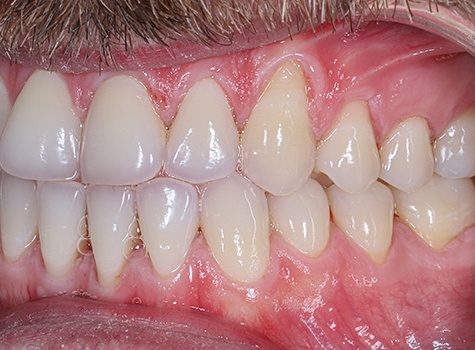
The most noticeable symptom of gum disease is bleeding after brushing or flossing. Swelling is also likely to occur when bacteria begin attacking these soft oral tissues. Should you notice this occurring, it’s best to call our office and get in to see us for treatment. The sooner you seek professional care, the less likely you’ll suffer more serious consequences later on.
Other typical symptoms associated with gum disease include:
- Redness of the gum tissue
- Halitosis or bad breath that doesn’t go away after brushing
- Gum recession (teeth appear longer than before)
- Gum tenderness
- Difficulty or pain while chewing
- Loose teeth
- Increased tooth sensitivity
- Changes in your bite
- Tooth loss
How Do We Treat Gum Disease?

Treating gum disease can include scaling and root planing or laser periodontal treatment. How we choose to proceed will ultimately be based on your individual needs. You can expect us to evaluate the severity of your condition before going over how we plan to address the issue and improve the state of your gum health.
Laser Periodontal Treatment
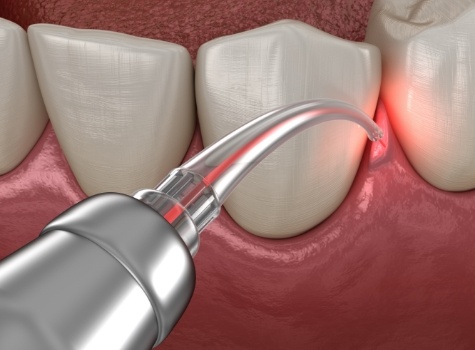
Typically, metal dental instruments would be used to perform scaling and root planing. Thanks to modern advances in dental technology, we can perform this same treatment in a more precise and comfortable way. Our soft tissue laser can remove infected tissue more accurately, making it easier to retain healthy existing tissue. Additionally, because the laser cauterizes tissue immediately following contact, you can expect less bleeding and less time needed for healing during your aftercare.
Scaling & Root Planing
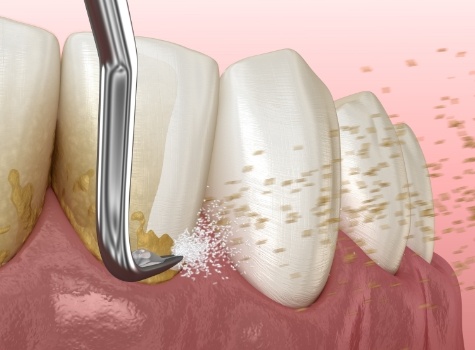
Treatment for advanced gum disease starts with a process known as scaling and root planing. Scaling is a common procedure that involves removing plaque and tartar from the surface of teeth, both above and below the gum line. This prevents future inflammation and infection of gum tissue. Root planing is designed to smooth out the roots of teeth so that the gums can reattach to the teeth. This effectively addresses gum recession, which occurs during the advanced stages of gum disease.
Do You Need Scaling & Root Planing?

To determine if scaling and root planing is right for you, Dr. Moulton needs to complete a detailed examination of your mouth. This means he’ll likely need to capture X-rays to collect as much information as possible. Depending on the condition of your gums, the depth of your gum pockets and the progression of periodontitis, he may recommend gum disease treatment with scaling and root planing.
The Process of Scaling & Root Planing
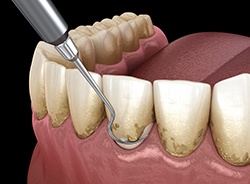
Scaling and root planing takes place in two parts, usually during two separate appointments. To remove calculus and plaque from tooth surfaces, Dr. Moulton will start with scaling. During your treatment, he’ll focus on plaque and tartar that sit beneath the gum line and along the root. To complete the scaling process, our dental office uses an ultrasonic scaling tool. This device also provides consistent irrigation during treatment, which applies antimicrobial agents below the gums. These agents promote the healing of gum tissue.
To remove cementum and surface dentin that is deep inside unwanted microorganisms, toxins, and tartar, Dr. Moulton performs root planing. By smoothing the roots of your teeth, we can promote healing and prevent bacteria from easily developing later.
Aftercare Tips for Scaling & Root Planing

It’s normal for the gums to feel sore following scaling and root planing. There also may be some inflammation. This is temporary and should be resolved in a few weeks. Here are some tips to help your gums heal quickly and efficiently.
- Brush twice a day using a soft-bristled toothbrush and fluoridated toothpaste.
- Rinse your mouth with salt water after meals to prevent irritation.
- Floss thoroughly every day.
- Stick to a soft food diet for 48 hours following your treatment.
- Avoid foods and drinks that are spicy, acidic, or hot.
- Refrain from intense physical activity after your treatment.
